BBS_5_MBL_S2: Tesco's Supply Chain Management Report
VerifiedAdded on 2023/01/11
|10
|3164
|2
Report
AI Summary
This report provides a comprehensive analysis of Tesco's supply chain management (SCM) system. It begins with background information on Tesco and its market outlook, followed by an examination of its supply chain and logistics management system, including techniques like direct-to-store delivery, centralization, and lean principles. The report identifies key challenges in implementing SCM systems, such as incorrect inventory cost assessment and demand forecasting, and explores the role of Radio Frequency Identification (RFID) technology in improving efficiency and lowering costs. Furthermore, the report discusses how Tesco embeds sustainable logistics throughout its supply chain, considering suppliers, manufacturers, distributors, and consumers. The analysis highlights Tesco's strategies for maintaining an efficient and sustainable supply chain within the competitive retail landscape.
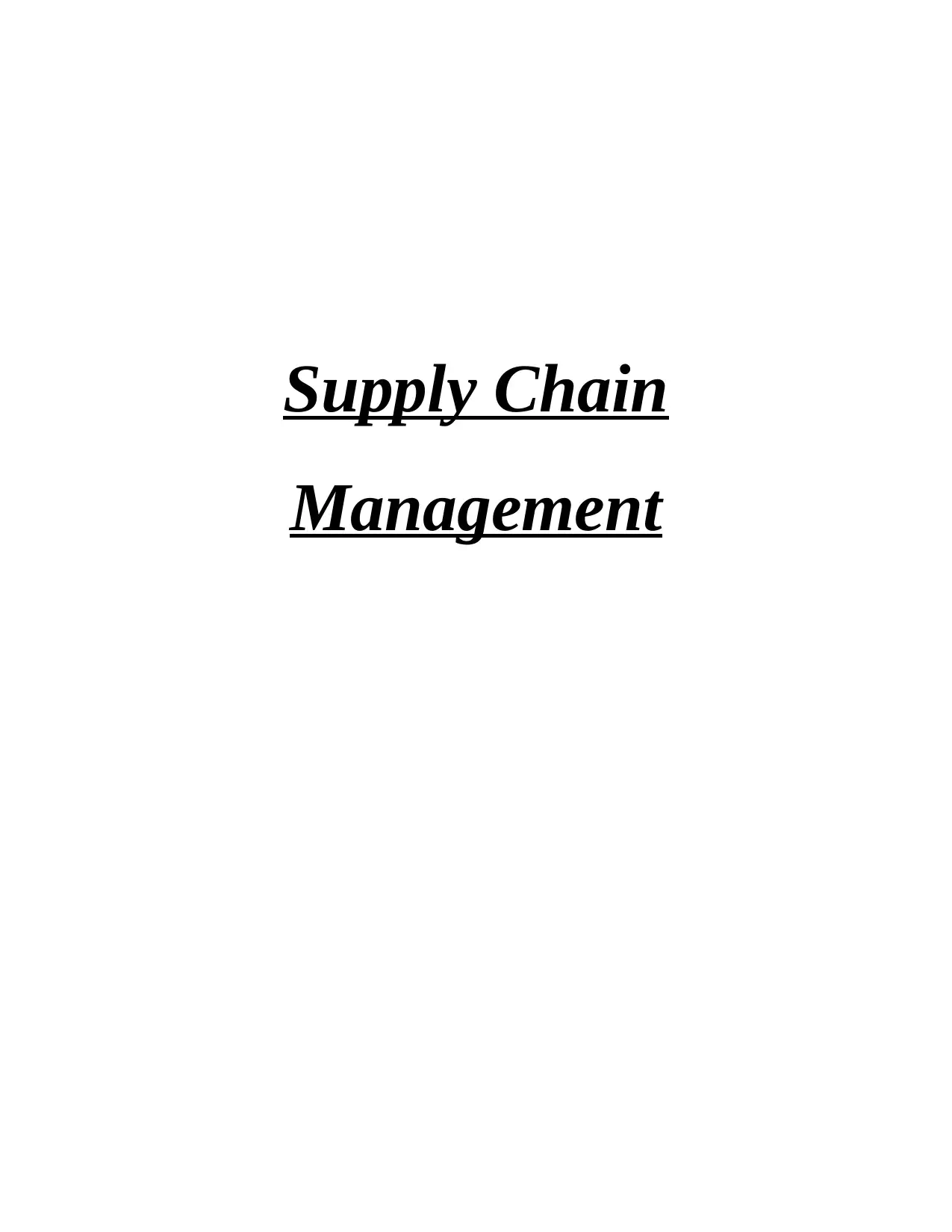
Supply Chain
Management
Management
Paraphrase This Document
Need a fresh take? Get an instant paraphrase of this document with our AI Paraphraser
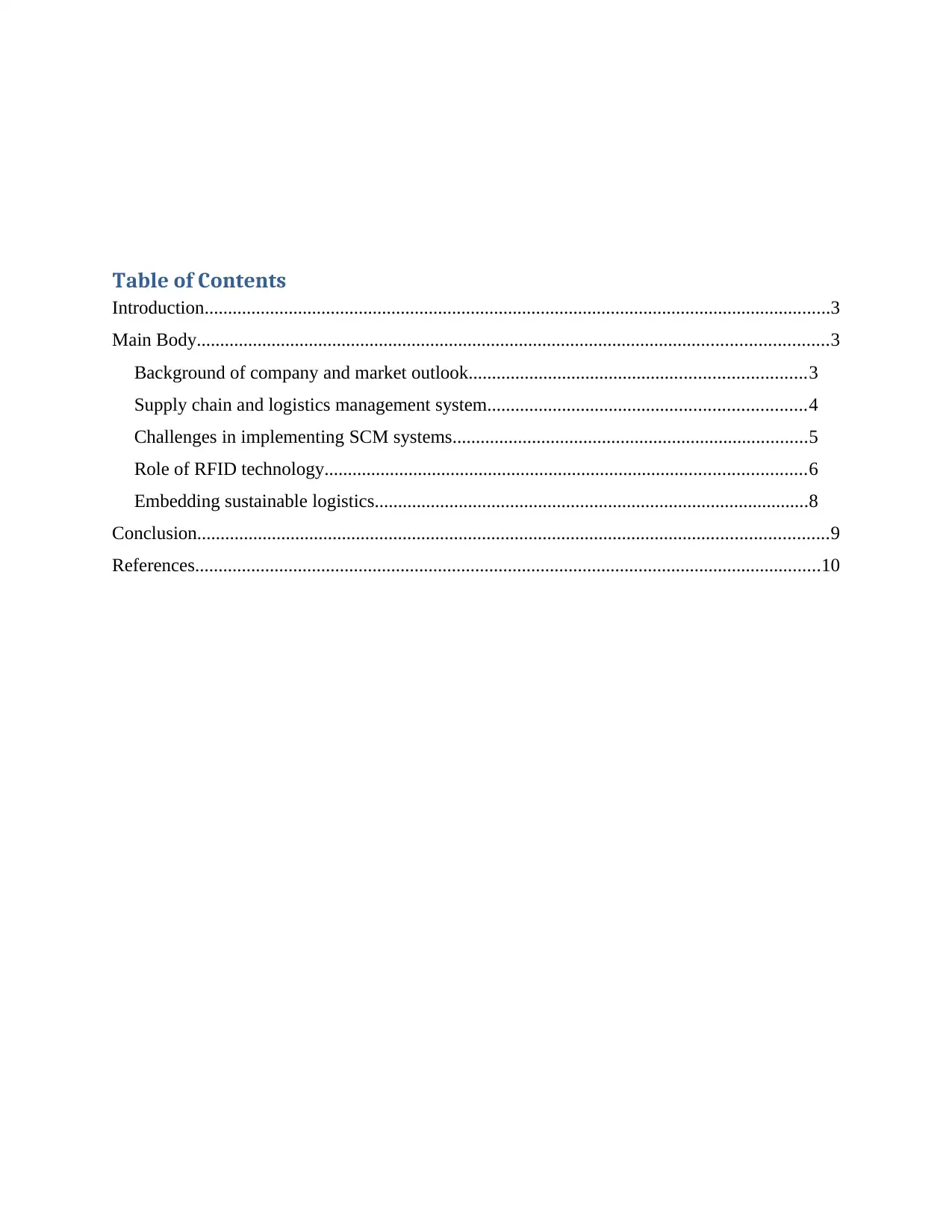
Table of Contents
Introduction......................................................................................................................................3
Main Body.......................................................................................................................................3
Background of company and market outlook........................................................................3
Supply chain and logistics management system....................................................................4
Challenges in implementing SCM systems............................................................................5
Role of RFID technology.......................................................................................................6
Embedding sustainable logistics.............................................................................................8
Conclusion.......................................................................................................................................9
References......................................................................................................................................10
Introduction......................................................................................................................................3
Main Body.......................................................................................................................................3
Background of company and market outlook........................................................................3
Supply chain and logistics management system....................................................................4
Challenges in implementing SCM systems............................................................................5
Role of RFID technology.......................................................................................................6
Embedding sustainable logistics.............................................................................................8
Conclusion.......................................................................................................................................9
References......................................................................................................................................10
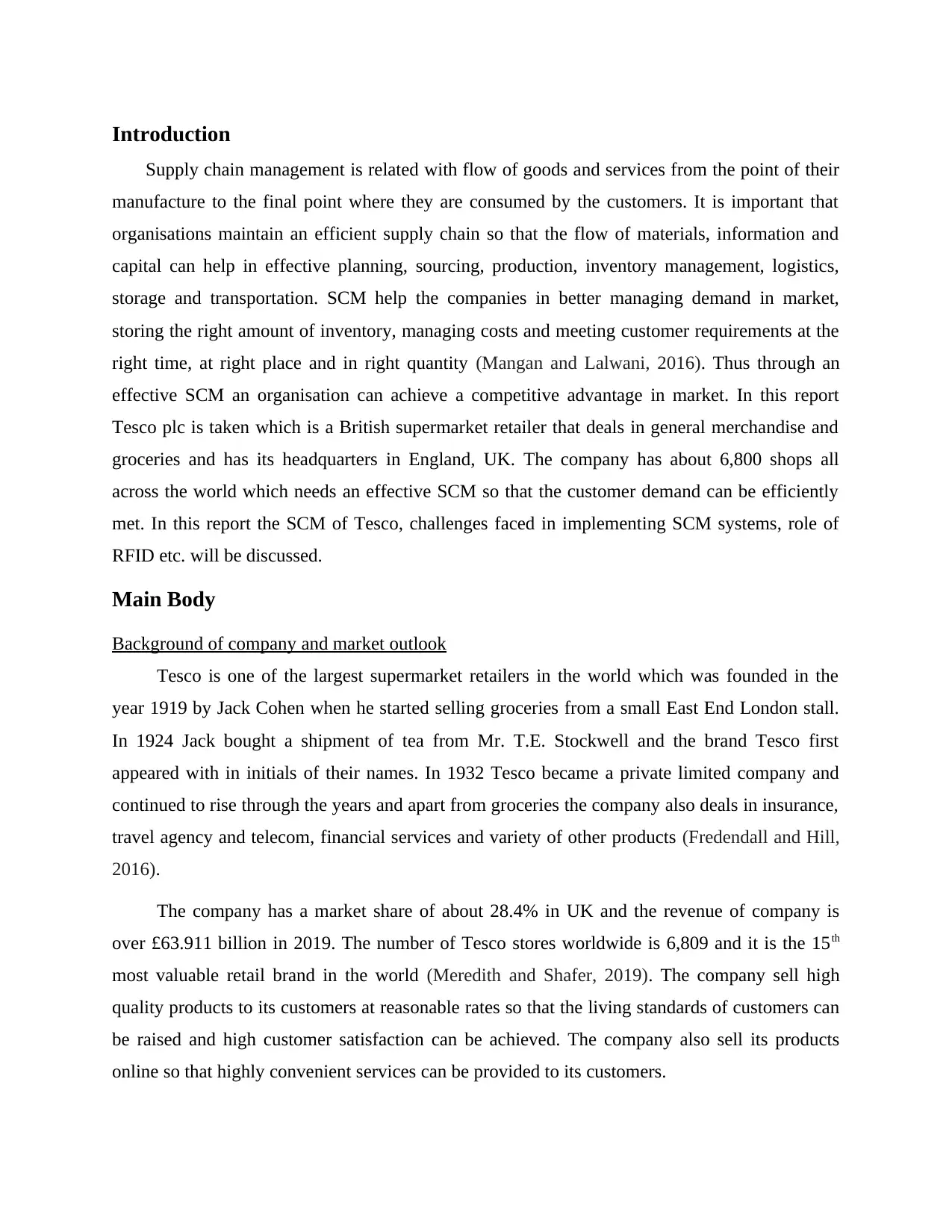
Introduction
Supply chain management is related with flow of goods and services from the point of their
manufacture to the final point where they are consumed by the customers. It is important that
organisations maintain an efficient supply chain so that the flow of materials, information and
capital can help in effective planning, sourcing, production, inventory management, logistics,
storage and transportation. SCM help the companies in better managing demand in market,
storing the right amount of inventory, managing costs and meeting customer requirements at the
right time, at right place and in right quantity (Mangan and Lalwani, 2016). Thus through an
effective SCM an organisation can achieve a competitive advantage in market. In this report
Tesco plc is taken which is a British supermarket retailer that deals in general merchandise and
groceries and has its headquarters in England, UK. The company has about 6,800 shops all
across the world which needs an effective SCM so that the customer demand can be efficiently
met. In this report the SCM of Tesco, challenges faced in implementing SCM systems, role of
RFID etc. will be discussed.
Main Body
Background of company and market outlook
Tesco is one of the largest supermarket retailers in the world which was founded in the
year 1919 by Jack Cohen when he started selling groceries from a small East End London stall.
In 1924 Jack bought a shipment of tea from Mr. T.E. Stockwell and the brand Tesco first
appeared with in initials of their names. In 1932 Tesco became a private limited company and
continued to rise through the years and apart from groceries the company also deals in insurance,
travel agency and telecom, financial services and variety of other products (Fredendall and Hill,
2016).
The company has a market share of about 28.4% in UK and the revenue of company is
over £63.911 billion in 2019. The number of Tesco stores worldwide is 6,809 and it is the 15th
most valuable retail brand in the world (Meredith and Shafer, 2019). The company sell high
quality products to its customers at reasonable rates so that the living standards of customers can
be raised and high customer satisfaction can be achieved. The company also sell its products
online so that highly convenient services can be provided to its customers.
Supply chain management is related with flow of goods and services from the point of their
manufacture to the final point where they are consumed by the customers. It is important that
organisations maintain an efficient supply chain so that the flow of materials, information and
capital can help in effective planning, sourcing, production, inventory management, logistics,
storage and transportation. SCM help the companies in better managing demand in market,
storing the right amount of inventory, managing costs and meeting customer requirements at the
right time, at right place and in right quantity (Mangan and Lalwani, 2016). Thus through an
effective SCM an organisation can achieve a competitive advantage in market. In this report
Tesco plc is taken which is a British supermarket retailer that deals in general merchandise and
groceries and has its headquarters in England, UK. The company has about 6,800 shops all
across the world which needs an effective SCM so that the customer demand can be efficiently
met. In this report the SCM of Tesco, challenges faced in implementing SCM systems, role of
RFID etc. will be discussed.
Main Body
Background of company and market outlook
Tesco is one of the largest supermarket retailers in the world which was founded in the
year 1919 by Jack Cohen when he started selling groceries from a small East End London stall.
In 1924 Jack bought a shipment of tea from Mr. T.E. Stockwell and the brand Tesco first
appeared with in initials of their names. In 1932 Tesco became a private limited company and
continued to rise through the years and apart from groceries the company also deals in insurance,
travel agency and telecom, financial services and variety of other products (Fredendall and Hill,
2016).
The company has a market share of about 28.4% in UK and the revenue of company is
over £63.911 billion in 2019. The number of Tesco stores worldwide is 6,809 and it is the 15th
most valuable retail brand in the world (Meredith and Shafer, 2019). The company sell high
quality products to its customers at reasonable rates so that the living standards of customers can
be raised and high customer satisfaction can be achieved. The company also sell its products
online so that highly convenient services can be provided to its customers.
⊘ This is a preview!⊘
Do you want full access?
Subscribe today to unlock all pages.

Trusted by 1+ million students worldwide
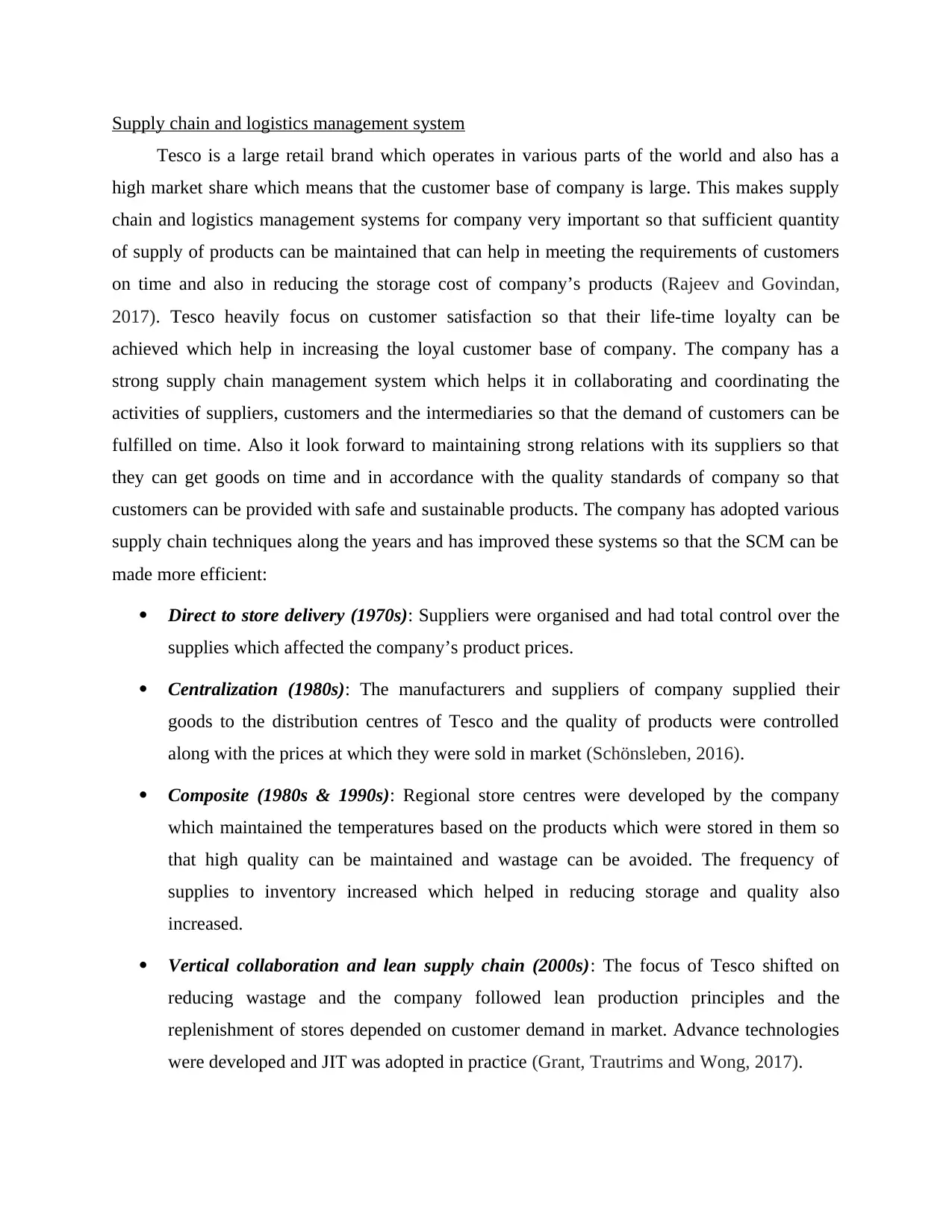
Supply chain and logistics management system
Tesco is a large retail brand which operates in various parts of the world and also has a
high market share which means that the customer base of company is large. This makes supply
chain and logistics management systems for company very important so that sufficient quantity
of supply of products can be maintained that can help in meeting the requirements of customers
on time and also in reducing the storage cost of company’s products (Rajeev and Govindan,
2017). Tesco heavily focus on customer satisfaction so that their life-time loyalty can be
achieved which help in increasing the loyal customer base of company. The company has a
strong supply chain management system which helps it in collaborating and coordinating the
activities of suppliers, customers and the intermediaries so that the demand of customers can be
fulfilled on time. Also it look forward to maintaining strong relations with its suppliers so that
they can get goods on time and in accordance with the quality standards of company so that
customers can be provided with safe and sustainable products. The company has adopted various
supply chain techniques along the years and has improved these systems so that the SCM can be
made more efficient:
Direct to store delivery (1970s): Suppliers were organised and had total control over the
supplies which affected the company’s product prices.
Centralization (1980s): The manufacturers and suppliers of company supplied their
goods to the distribution centres of Tesco and the quality of products were controlled
along with the prices at which they were sold in market (Schönsleben, 2016).
Composite (1980s & 1990s): Regional store centres were developed by the company
which maintained the temperatures based on the products which were stored in them so
that high quality can be maintained and wastage can be avoided. The frequency of
supplies to inventory increased which helped in reducing storage and quality also
increased.
Vertical collaboration and lean supply chain (2000s): The focus of Tesco shifted on
reducing wastage and the company followed lean production principles and the
replenishment of stores depended on customer demand in market. Advance technologies
were developed and JIT was adopted in practice (Grant, Trautrims and Wong, 2017).
Tesco is a large retail brand which operates in various parts of the world and also has a
high market share which means that the customer base of company is large. This makes supply
chain and logistics management systems for company very important so that sufficient quantity
of supply of products can be maintained that can help in meeting the requirements of customers
on time and also in reducing the storage cost of company’s products (Rajeev and Govindan,
2017). Tesco heavily focus on customer satisfaction so that their life-time loyalty can be
achieved which help in increasing the loyal customer base of company. The company has a
strong supply chain management system which helps it in collaborating and coordinating the
activities of suppliers, customers and the intermediaries so that the demand of customers can be
fulfilled on time. Also it look forward to maintaining strong relations with its suppliers so that
they can get goods on time and in accordance with the quality standards of company so that
customers can be provided with safe and sustainable products. The company has adopted various
supply chain techniques along the years and has improved these systems so that the SCM can be
made more efficient:
Direct to store delivery (1970s): Suppliers were organised and had total control over the
supplies which affected the company’s product prices.
Centralization (1980s): The manufacturers and suppliers of company supplied their
goods to the distribution centres of Tesco and the quality of products were controlled
along with the prices at which they were sold in market (Schönsleben, 2016).
Composite (1980s & 1990s): Regional store centres were developed by the company
which maintained the temperatures based on the products which were stored in them so
that high quality can be maintained and wastage can be avoided. The frequency of
supplies to inventory increased which helped in reducing storage and quality also
increased.
Vertical collaboration and lean supply chain (2000s): The focus of Tesco shifted on
reducing wastage and the company followed lean production principles and the
replenishment of stores depended on customer demand in market. Advance technologies
were developed and JIT was adopted in practice (Grant, Trautrims and Wong, 2017).
Paraphrase This Document
Need a fresh take? Get an instant paraphrase of this document with our AI Paraphraser
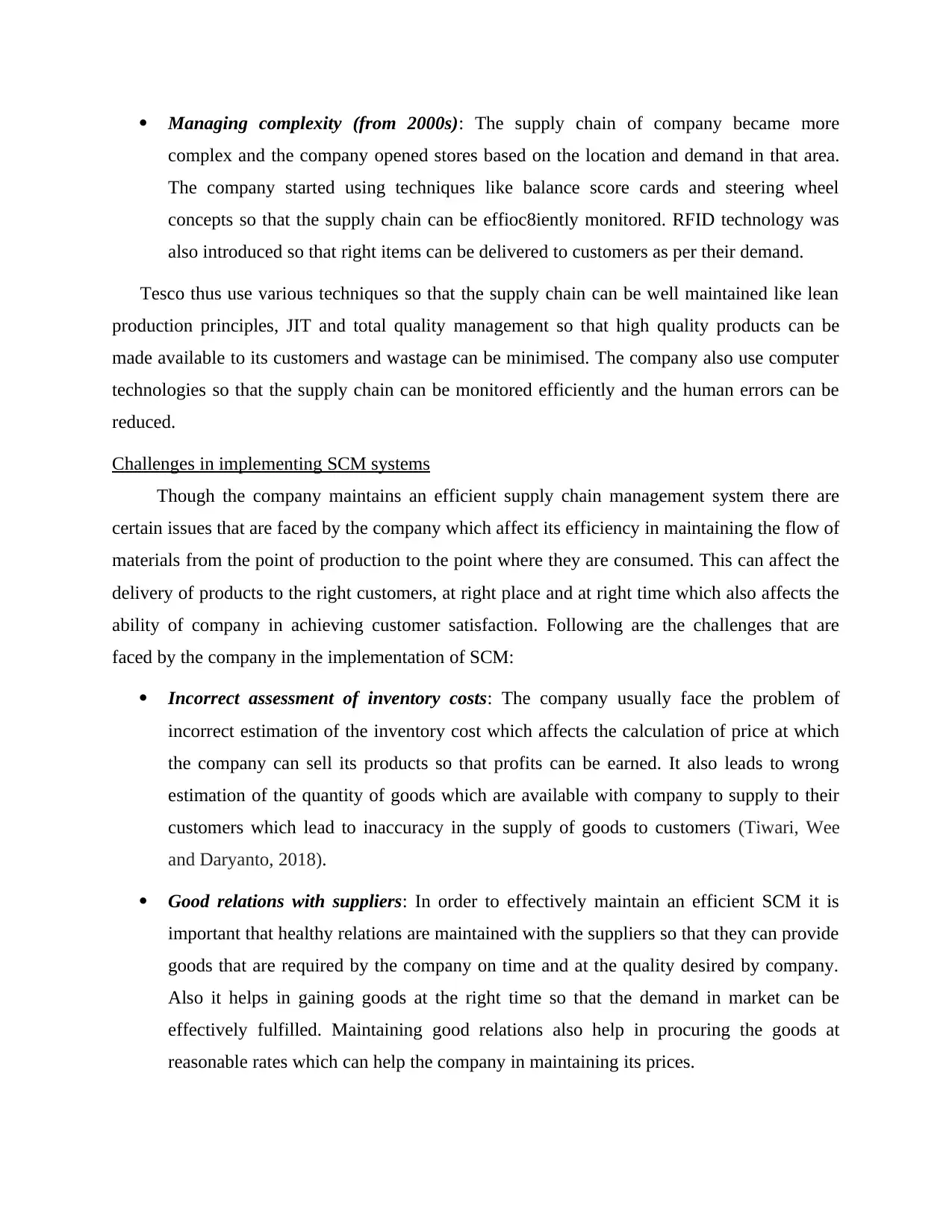
Managing complexity (from 2000s): The supply chain of company became more
complex and the company opened stores based on the location and demand in that area.
The company started using techniques like balance score cards and steering wheel
concepts so that the supply chain can be effioc8iently monitored. RFID technology was
also introduced so that right items can be delivered to customers as per their demand.
Tesco thus use various techniques so that the supply chain can be well maintained like lean
production principles, JIT and total quality management so that high quality products can be
made available to its customers and wastage can be minimised. The company also use computer
technologies so that the supply chain can be monitored efficiently and the human errors can be
reduced.
Challenges in implementing SCM systems
Though the company maintains an efficient supply chain management system there are
certain issues that are faced by the company which affect its efficiency in maintaining the flow of
materials from the point of production to the point where they are consumed. This can affect the
delivery of products to the right customers, at right place and at right time which also affects the
ability of company in achieving customer satisfaction. Following are the challenges that are
faced by the company in the implementation of SCM:
Incorrect assessment of inventory costs: The company usually face the problem of
incorrect estimation of the inventory cost which affects the calculation of price at which
the company can sell its products so that profits can be earned. It also leads to wrong
estimation of the quantity of goods which are available with company to supply to their
customers which lead to inaccuracy in the supply of goods to customers (Tiwari, Wee
and Daryanto, 2018).
Good relations with suppliers: In order to effectively maintain an efficient SCM it is
important that healthy relations are maintained with the suppliers so that they can provide
goods that are required by the company on time and at the quality desired by company.
Also it helps in gaining goods at the right time so that the demand in market can be
effectively fulfilled. Maintaining good relations also help in procuring the goods at
reasonable rates which can help the company in maintaining its prices.
complex and the company opened stores based on the location and demand in that area.
The company started using techniques like balance score cards and steering wheel
concepts so that the supply chain can be effioc8iently monitored. RFID technology was
also introduced so that right items can be delivered to customers as per their demand.
Tesco thus use various techniques so that the supply chain can be well maintained like lean
production principles, JIT and total quality management so that high quality products can be
made available to its customers and wastage can be minimised. The company also use computer
technologies so that the supply chain can be monitored efficiently and the human errors can be
reduced.
Challenges in implementing SCM systems
Though the company maintains an efficient supply chain management system there are
certain issues that are faced by the company which affect its efficiency in maintaining the flow of
materials from the point of production to the point where they are consumed. This can affect the
delivery of products to the right customers, at right place and at right time which also affects the
ability of company in achieving customer satisfaction. Following are the challenges that are
faced by the company in the implementation of SCM:
Incorrect assessment of inventory costs: The company usually face the problem of
incorrect estimation of the inventory cost which affects the calculation of price at which
the company can sell its products so that profits can be earned. It also leads to wrong
estimation of the quantity of goods which are available with company to supply to their
customers which lead to inaccuracy in the supply of goods to customers (Tiwari, Wee
and Daryanto, 2018).
Good relations with suppliers: In order to effectively maintain an efficient SCM it is
important that healthy relations are maintained with the suppliers so that they can provide
goods that are required by the company on time and at the quality desired by company.
Also it helps in gaining goods at the right time so that the demand in market can be
effectively fulfilled. Maintaining good relations also help in procuring the goods at
reasonable rates which can help the company in maintaining its prices.
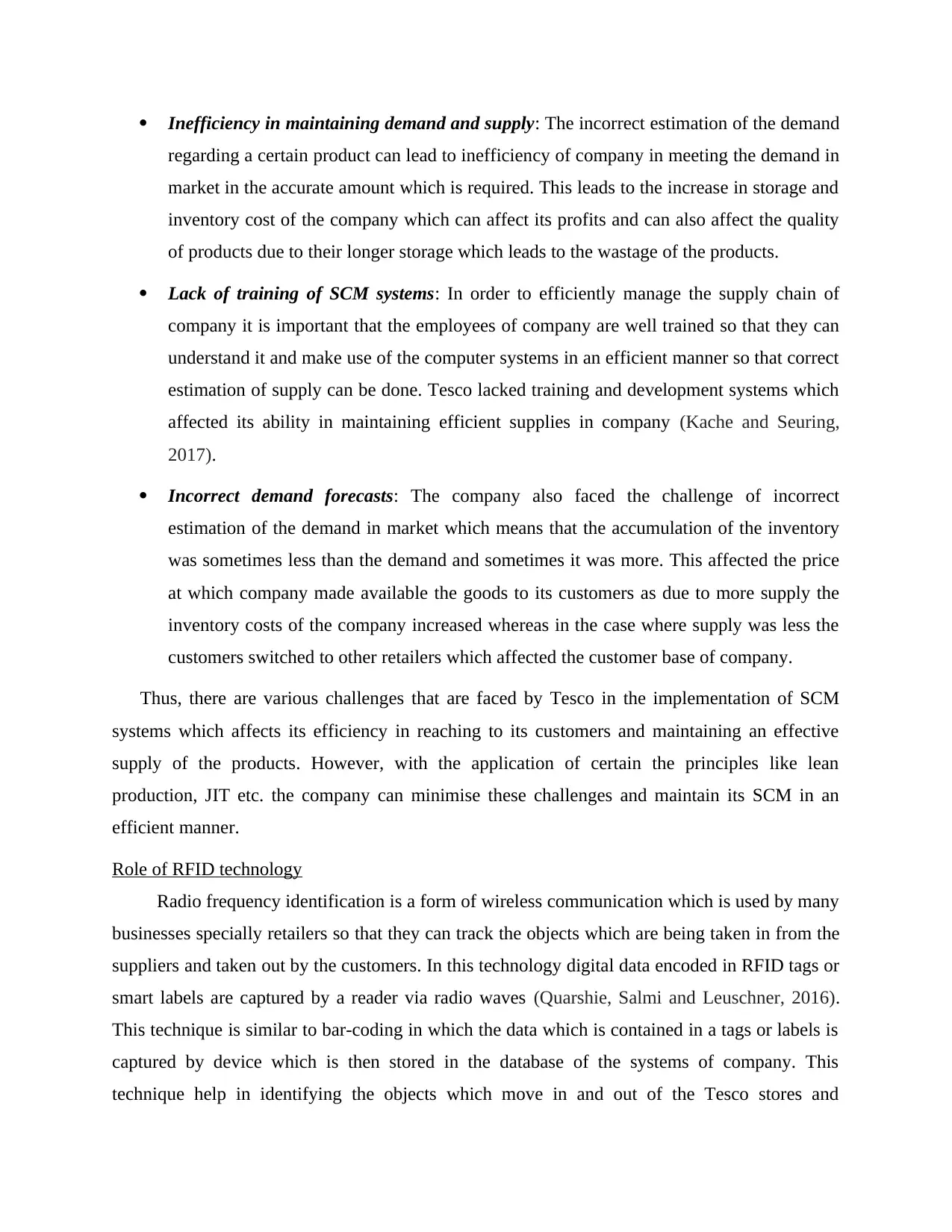
Inefficiency in maintaining demand and supply: The incorrect estimation of the demand
regarding a certain product can lead to inefficiency of company in meeting the demand in
market in the accurate amount which is required. This leads to the increase in storage and
inventory cost of the company which can affect its profits and can also affect the quality
of products due to their longer storage which leads to the wastage of the products.
Lack of training of SCM systems: In order to efficiently manage the supply chain of
company it is important that the employees of company are well trained so that they can
understand it and make use of the computer systems in an efficient manner so that correct
estimation of supply can be done. Tesco lacked training and development systems which
affected its ability in maintaining efficient supplies in company (Kache and Seuring,
2017).
Incorrect demand forecasts: The company also faced the challenge of incorrect
estimation of the demand in market which means that the accumulation of the inventory
was sometimes less than the demand and sometimes it was more. This affected the price
at which company made available the goods to its customers as due to more supply the
inventory costs of the company increased whereas in the case where supply was less the
customers switched to other retailers which affected the customer base of company.
Thus, there are various challenges that are faced by Tesco in the implementation of SCM
systems which affects its efficiency in reaching to its customers and maintaining an effective
supply of the products. However, with the application of certain the principles like lean
production, JIT etc. the company can minimise these challenges and maintain its SCM in an
efficient manner.
Role of RFID technology
Radio frequency identification is a form of wireless communication which is used by many
businesses specially retailers so that they can track the objects which are being taken in from the
suppliers and taken out by the customers. In this technology digital data encoded in RFID tags or
smart labels are captured by a reader via radio waves (Quarshie, Salmi and Leuschner, 2016).
This technique is similar to bar-coding in which the data which is contained in a tags or labels is
captured by device which is then stored in the database of the systems of company. This
technique help in identifying the objects which move in and out of the Tesco stores and
regarding a certain product can lead to inefficiency of company in meeting the demand in
market in the accurate amount which is required. This leads to the increase in storage and
inventory cost of the company which can affect its profits and can also affect the quality
of products due to their longer storage which leads to the wastage of the products.
Lack of training of SCM systems: In order to efficiently manage the supply chain of
company it is important that the employees of company are well trained so that they can
understand it and make use of the computer systems in an efficient manner so that correct
estimation of supply can be done. Tesco lacked training and development systems which
affected its ability in maintaining efficient supplies in company (Kache and Seuring,
2017).
Incorrect demand forecasts: The company also faced the challenge of incorrect
estimation of the demand in market which means that the accumulation of the inventory
was sometimes less than the demand and sometimes it was more. This affected the price
at which company made available the goods to its customers as due to more supply the
inventory costs of the company increased whereas in the case where supply was less the
customers switched to other retailers which affected the customer base of company.
Thus, there are various challenges that are faced by Tesco in the implementation of SCM
systems which affects its efficiency in reaching to its customers and maintaining an effective
supply of the products. However, with the application of certain the principles like lean
production, JIT etc. the company can minimise these challenges and maintain its SCM in an
efficient manner.
Role of RFID technology
Radio frequency identification is a form of wireless communication which is used by many
businesses specially retailers so that they can track the objects which are being taken in from the
suppliers and taken out by the customers. In this technology digital data encoded in RFID tags or
smart labels are captured by a reader via radio waves (Quarshie, Salmi and Leuschner, 2016).
This technique is similar to bar-coding in which the data which is contained in a tags or labels is
captured by device which is then stored in the database of the systems of company. This
technique help in identifying the objects which move in and out of the Tesco stores and
⊘ This is a preview!⊘
Do you want full access?
Subscribe today to unlock all pages.

Trusted by 1+ million students worldwide
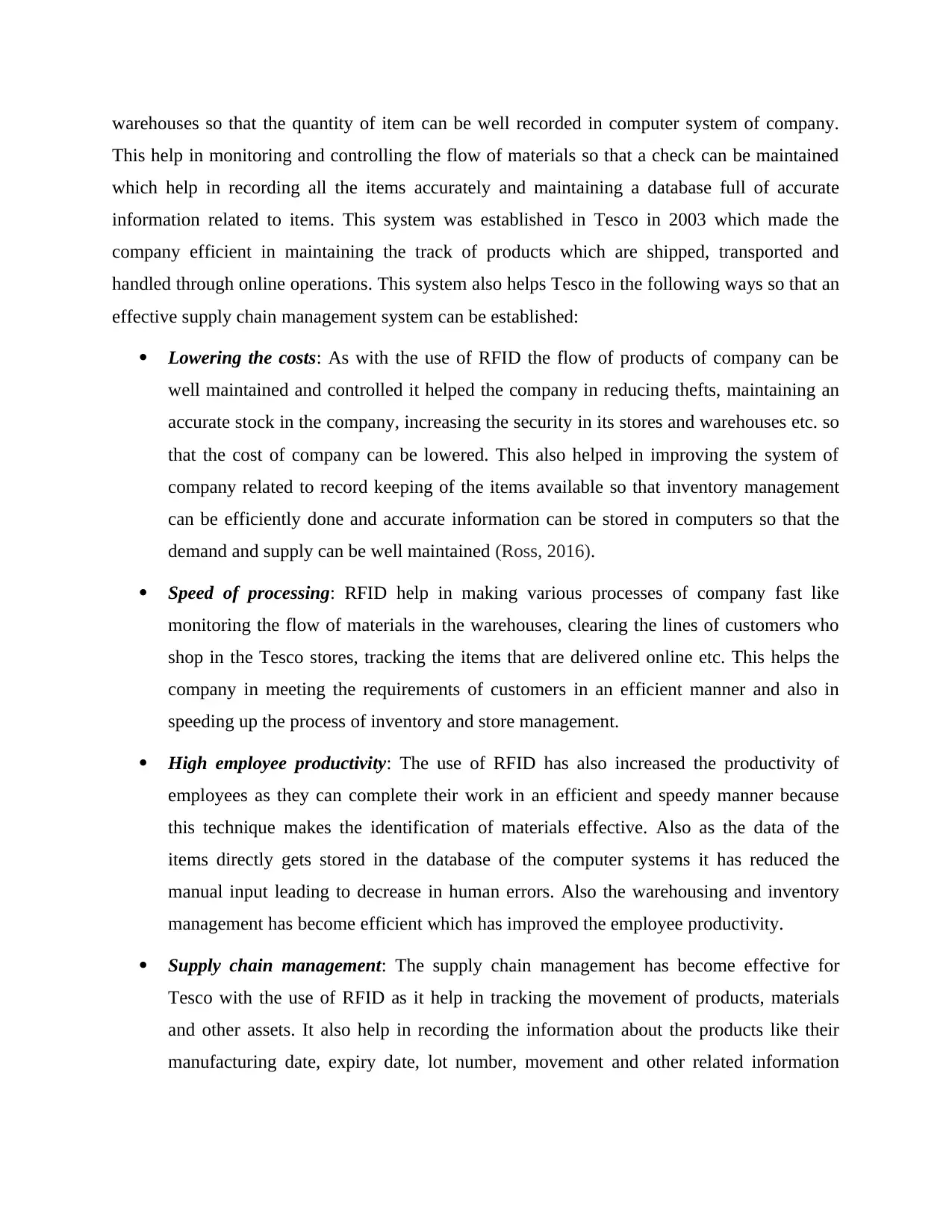
warehouses so that the quantity of item can be well recorded in computer system of company.
This help in monitoring and controlling the flow of materials so that a check can be maintained
which help in recording all the items accurately and maintaining a database full of accurate
information related to items. This system was established in Tesco in 2003 which made the
company efficient in maintaining the track of products which are shipped, transported and
handled through online operations. This system also helps Tesco in the following ways so that an
effective supply chain management system can be established:
Lowering the costs: As with the use of RFID the flow of products of company can be
well maintained and controlled it helped the company in reducing thefts, maintaining an
accurate stock in the company, increasing the security in its stores and warehouses etc. so
that the cost of company can be lowered. This also helped in improving the system of
company related to record keeping of the items available so that inventory management
can be efficiently done and accurate information can be stored in computers so that the
demand and supply can be well maintained (Ross, 2016).
Speed of processing: RFID help in making various processes of company fast like
monitoring the flow of materials in the warehouses, clearing the lines of customers who
shop in the Tesco stores, tracking the items that are delivered online etc. This helps the
company in meeting the requirements of customers in an efficient manner and also in
speeding up the process of inventory and store management.
High employee productivity: The use of RFID has also increased the productivity of
employees as they can complete their work in an efficient and speedy manner because
this technique makes the identification of materials effective. Also as the data of the
items directly gets stored in the database of the computer systems it has reduced the
manual input leading to decrease in human errors. Also the warehousing and inventory
management has become efficient which has improved the employee productivity.
Supply chain management: The supply chain management has become effective for
Tesco with the use of RFID as it help in tracking the movement of products, materials
and other assets. It also help in recording the information about the products like their
manufacturing date, expiry date, lot number, movement and other related information
This help in monitoring and controlling the flow of materials so that a check can be maintained
which help in recording all the items accurately and maintaining a database full of accurate
information related to items. This system was established in Tesco in 2003 which made the
company efficient in maintaining the track of products which are shipped, transported and
handled through online operations. This system also helps Tesco in the following ways so that an
effective supply chain management system can be established:
Lowering the costs: As with the use of RFID the flow of products of company can be
well maintained and controlled it helped the company in reducing thefts, maintaining an
accurate stock in the company, increasing the security in its stores and warehouses etc. so
that the cost of company can be lowered. This also helped in improving the system of
company related to record keeping of the items available so that inventory management
can be efficiently done and accurate information can be stored in computers so that the
demand and supply can be well maintained (Ross, 2016).
Speed of processing: RFID help in making various processes of company fast like
monitoring the flow of materials in the warehouses, clearing the lines of customers who
shop in the Tesco stores, tracking the items that are delivered online etc. This helps the
company in meeting the requirements of customers in an efficient manner and also in
speeding up the process of inventory and store management.
High employee productivity: The use of RFID has also increased the productivity of
employees as they can complete their work in an efficient and speedy manner because
this technique makes the identification of materials effective. Also as the data of the
items directly gets stored in the database of the computer systems it has reduced the
manual input leading to decrease in human errors. Also the warehousing and inventory
management has become efficient which has improved the employee productivity.
Supply chain management: The supply chain management has become effective for
Tesco with the use of RFID as it help in tracking the movement of products, materials
and other assets. It also help in recording the information about the products like their
manufacturing date, expiry date, lot number, movement and other related information
Paraphrase This Document
Need a fresh take? Get an instant paraphrase of this document with our AI Paraphraser
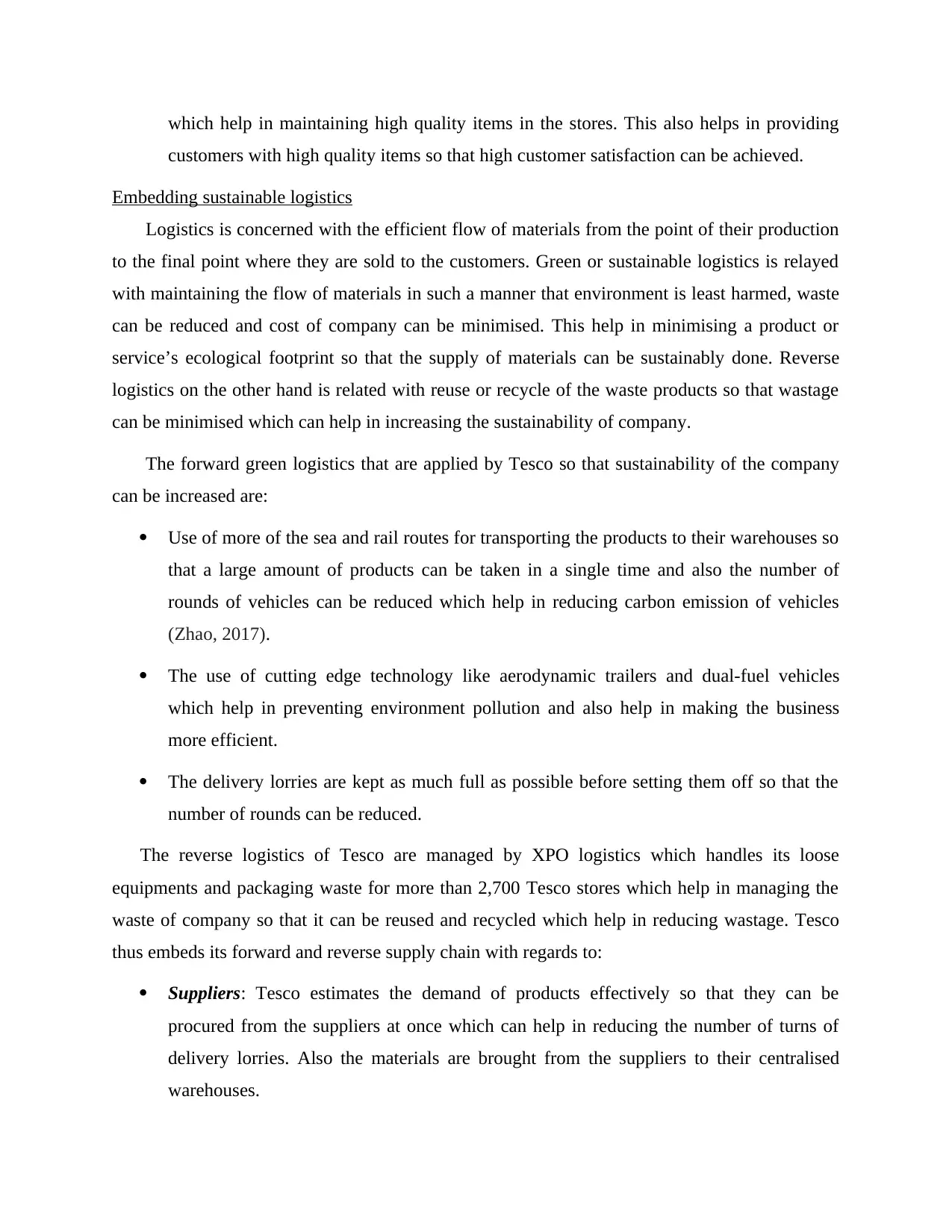
which help in maintaining high quality items in the stores. This also helps in providing
customers with high quality items so that high customer satisfaction can be achieved.
Embedding sustainable logistics
Logistics is concerned with the efficient flow of materials from the point of their production
to the final point where they are sold to the customers. Green or sustainable logistics is relayed
with maintaining the flow of materials in such a manner that environment is least harmed, waste
can be reduced and cost of company can be minimised. This help in minimising a product or
service’s ecological footprint so that the supply of materials can be sustainably done. Reverse
logistics on the other hand is related with reuse or recycle of the waste products so that wastage
can be minimised which can help in increasing the sustainability of company.
The forward green logistics that are applied by Tesco so that sustainability of the company
can be increased are:
Use of more of the sea and rail routes for transporting the products to their warehouses so
that a large amount of products can be taken in a single time and also the number of
rounds of vehicles can be reduced which help in reducing carbon emission of vehicles
(Zhao, 2017).
The use of cutting edge technology like aerodynamic trailers and dual-fuel vehicles
which help in preventing environment pollution and also help in making the business
more efficient.
The delivery lorries are kept as much full as possible before setting them off so that the
number of rounds can be reduced.
The reverse logistics of Tesco are managed by XPO logistics which handles its loose
equipments and packaging waste for more than 2,700 Tesco stores which help in managing the
waste of company so that it can be reused and recycled which help in reducing wastage. Tesco
thus embeds its forward and reverse supply chain with regards to:
Suppliers: Tesco estimates the demand of products effectively so that they can be
procured from the suppliers at once which can help in reducing the number of turns of
delivery lorries. Also the materials are brought from the suppliers to their centralised
warehouses.
customers with high quality items so that high customer satisfaction can be achieved.
Embedding sustainable logistics
Logistics is concerned with the efficient flow of materials from the point of their production
to the final point where they are sold to the customers. Green or sustainable logistics is relayed
with maintaining the flow of materials in such a manner that environment is least harmed, waste
can be reduced and cost of company can be minimised. This help in minimising a product or
service’s ecological footprint so that the supply of materials can be sustainably done. Reverse
logistics on the other hand is related with reuse or recycle of the waste products so that wastage
can be minimised which can help in increasing the sustainability of company.
The forward green logistics that are applied by Tesco so that sustainability of the company
can be increased are:
Use of more of the sea and rail routes for transporting the products to their warehouses so
that a large amount of products can be taken in a single time and also the number of
rounds of vehicles can be reduced which help in reducing carbon emission of vehicles
(Zhao, 2017).
The use of cutting edge technology like aerodynamic trailers and dual-fuel vehicles
which help in preventing environment pollution and also help in making the business
more efficient.
The delivery lorries are kept as much full as possible before setting them off so that the
number of rounds can be reduced.
The reverse logistics of Tesco are managed by XPO logistics which handles its loose
equipments and packaging waste for more than 2,700 Tesco stores which help in managing the
waste of company so that it can be reused and recycled which help in reducing wastage. Tesco
thus embeds its forward and reverse supply chain with regards to:
Suppliers: Tesco estimates the demand of products effectively so that they can be
procured from the suppliers at once which can help in reducing the number of turns of
delivery lorries. Also the materials are brought from the suppliers to their centralised
warehouses.
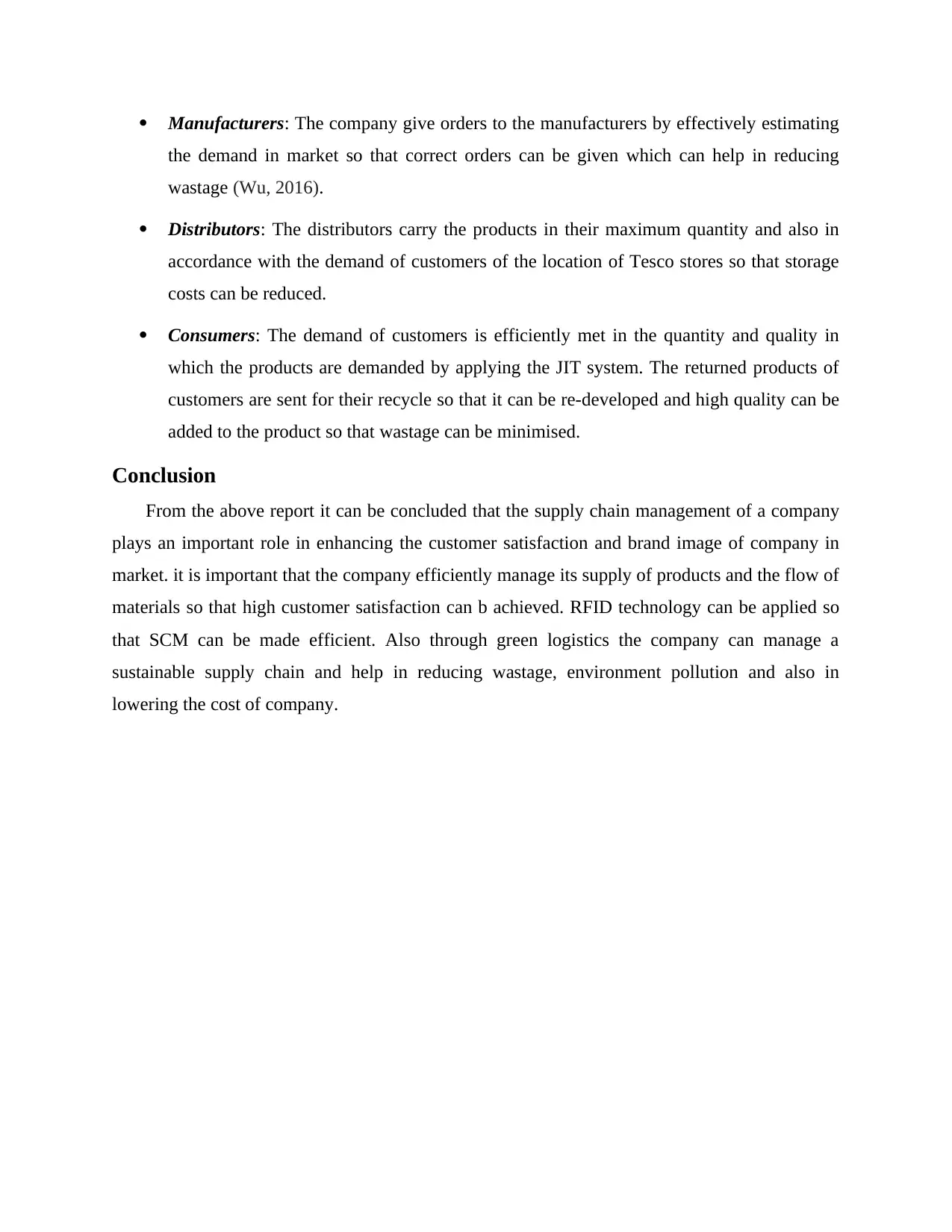
Manufacturers: The company give orders to the manufacturers by effectively estimating
the demand in market so that correct orders can be given which can help in reducing
wastage (Wu, 2016).
Distributors: The distributors carry the products in their maximum quantity and also in
accordance with the demand of customers of the location of Tesco stores so that storage
costs can be reduced.
Consumers: The demand of customers is efficiently met in the quantity and quality in
which the products are demanded by applying the JIT system. The returned products of
customers are sent for their recycle so that it can be re-developed and high quality can be
added to the product so that wastage can be minimised.
Conclusion
From the above report it can be concluded that the supply chain management of a company
plays an important role in enhancing the customer satisfaction and brand image of company in
market. it is important that the company efficiently manage its supply of products and the flow of
materials so that high customer satisfaction can b achieved. RFID technology can be applied so
that SCM can be made efficient. Also through green logistics the company can manage a
sustainable supply chain and help in reducing wastage, environment pollution and also in
lowering the cost of company.
the demand in market so that correct orders can be given which can help in reducing
wastage (Wu, 2016).
Distributors: The distributors carry the products in their maximum quantity and also in
accordance with the demand of customers of the location of Tesco stores so that storage
costs can be reduced.
Consumers: The demand of customers is efficiently met in the quantity and quality in
which the products are demanded by applying the JIT system. The returned products of
customers are sent for their recycle so that it can be re-developed and high quality can be
added to the product so that wastage can be minimised.
Conclusion
From the above report it can be concluded that the supply chain management of a company
plays an important role in enhancing the customer satisfaction and brand image of company in
market. it is important that the company efficiently manage its supply of products and the flow of
materials so that high customer satisfaction can b achieved. RFID technology can be applied so
that SCM can be made efficient. Also through green logistics the company can manage a
sustainable supply chain and help in reducing wastage, environment pollution and also in
lowering the cost of company.
⊘ This is a preview!⊘
Do you want full access?
Subscribe today to unlock all pages.

Trusted by 1+ million students worldwide
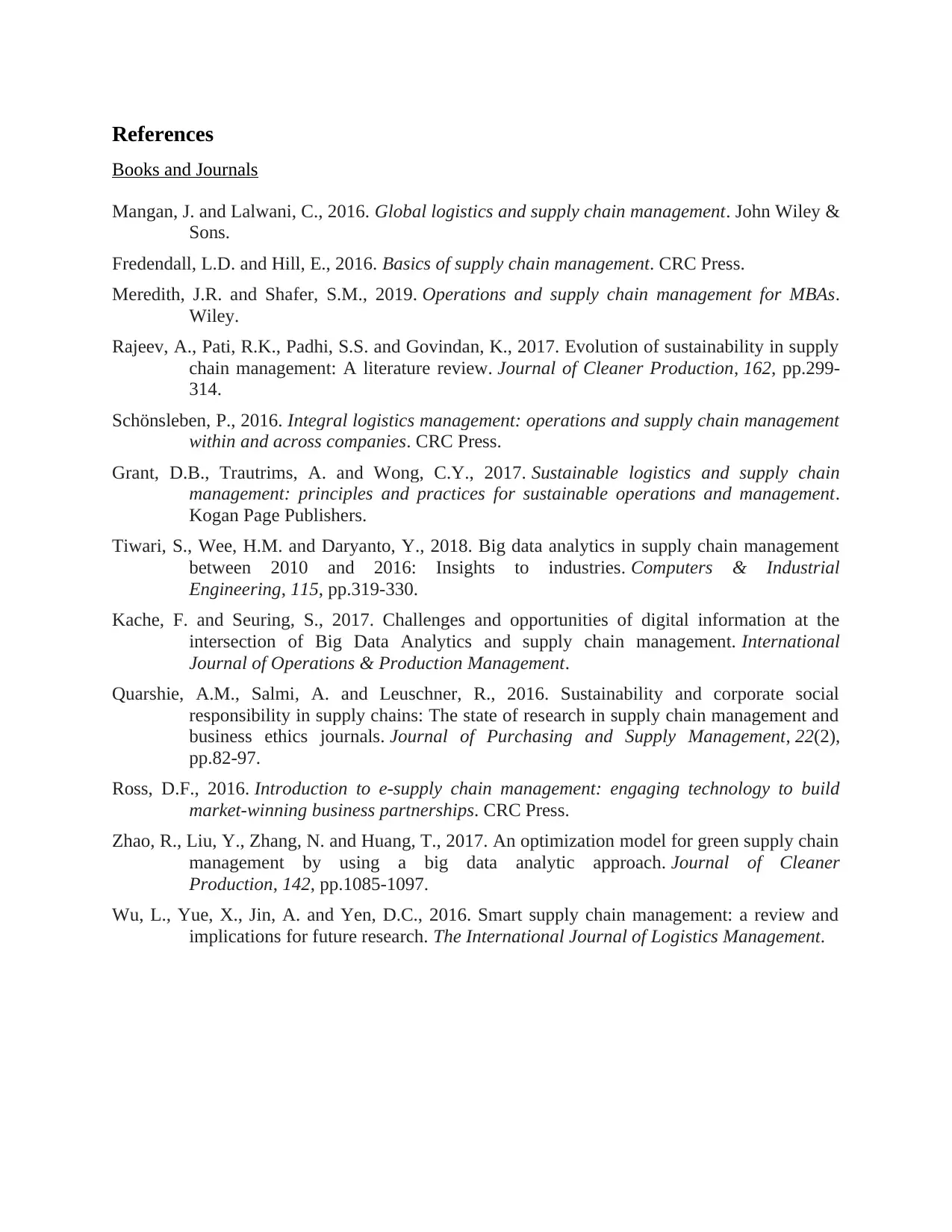
References
Books and Journals
Mangan, J. and Lalwani, C., 2016. Global logistics and supply chain management. John Wiley &
Sons.
Fredendall, L.D. and Hill, E., 2016. Basics of supply chain management. CRC Press.
Meredith, J.R. and Shafer, S.M., 2019. Operations and supply chain management for MBAs.
Wiley.
Rajeev, A., Pati, R.K., Padhi, S.S. and Govindan, K., 2017. Evolution of sustainability in supply
chain management: A literature review. Journal of Cleaner Production, 162, pp.299-
314.
Schönsleben, P., 2016. Integral logistics management: operations and supply chain management
within and across companies. CRC Press.
Grant, D.B., Trautrims, A. and Wong, C.Y., 2017. Sustainable logistics and supply chain
management: principles and practices for sustainable operations and management.
Kogan Page Publishers.
Tiwari, S., Wee, H.M. and Daryanto, Y., 2018. Big data analytics in supply chain management
between 2010 and 2016: Insights to industries. Computers & Industrial
Engineering, 115, pp.319-330.
Kache, F. and Seuring, S., 2017. Challenges and opportunities of digital information at the
intersection of Big Data Analytics and supply chain management. International
Journal of Operations & Production Management.
Quarshie, A.M., Salmi, A. and Leuschner, R., 2016. Sustainability and corporate social
responsibility in supply chains: The state of research in supply chain management and
business ethics journals. Journal of Purchasing and Supply Management, 22(2),
pp.82-97.
Ross, D.F., 2016. Introduction to e-supply chain management: engaging technology to build
market-winning business partnerships. CRC Press.
Zhao, R., Liu, Y., Zhang, N. and Huang, T., 2017. An optimization model for green supply chain
management by using a big data analytic approach. Journal of Cleaner
Production, 142, pp.1085-1097.
Wu, L., Yue, X., Jin, A. and Yen, D.C., 2016. Smart supply chain management: a review and
implications for future research. The International Journal of Logistics Management.
Books and Journals
Mangan, J. and Lalwani, C., 2016. Global logistics and supply chain management. John Wiley &
Sons.
Fredendall, L.D. and Hill, E., 2016. Basics of supply chain management. CRC Press.
Meredith, J.R. and Shafer, S.M., 2019. Operations and supply chain management for MBAs.
Wiley.
Rajeev, A., Pati, R.K., Padhi, S.S. and Govindan, K., 2017. Evolution of sustainability in supply
chain management: A literature review. Journal of Cleaner Production, 162, pp.299-
314.
Schönsleben, P., 2016. Integral logistics management: operations and supply chain management
within and across companies. CRC Press.
Grant, D.B., Trautrims, A. and Wong, C.Y., 2017. Sustainable logistics and supply chain
management: principles and practices for sustainable operations and management.
Kogan Page Publishers.
Tiwari, S., Wee, H.M. and Daryanto, Y., 2018. Big data analytics in supply chain management
between 2010 and 2016: Insights to industries. Computers & Industrial
Engineering, 115, pp.319-330.
Kache, F. and Seuring, S., 2017. Challenges and opportunities of digital information at the
intersection of Big Data Analytics and supply chain management. International
Journal of Operations & Production Management.
Quarshie, A.M., Salmi, A. and Leuschner, R., 2016. Sustainability and corporate social
responsibility in supply chains: The state of research in supply chain management and
business ethics journals. Journal of Purchasing and Supply Management, 22(2),
pp.82-97.
Ross, D.F., 2016. Introduction to e-supply chain management: engaging technology to build
market-winning business partnerships. CRC Press.
Zhao, R., Liu, Y., Zhang, N. and Huang, T., 2017. An optimization model for green supply chain
management by using a big data analytic approach. Journal of Cleaner
Production, 142, pp.1085-1097.
Wu, L., Yue, X., Jin, A. and Yen, D.C., 2016. Smart supply chain management: a review and
implications for future research. The International Journal of Logistics Management.
1 out of 10
Related Documents
Your All-in-One AI-Powered Toolkit for Academic Success.
+13062052269
info@desklib.com
Available 24*7 on WhatsApp / Email
![[object Object]](/_next/static/media/star-bottom.7253800d.svg)
Unlock your academic potential
Copyright © 2020–2025 A2Z Services. All Rights Reserved. Developed and managed by ZUCOL.





